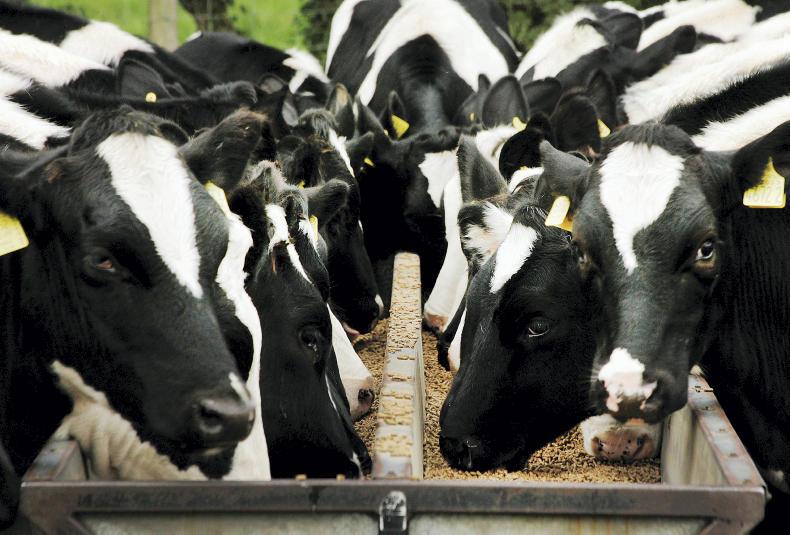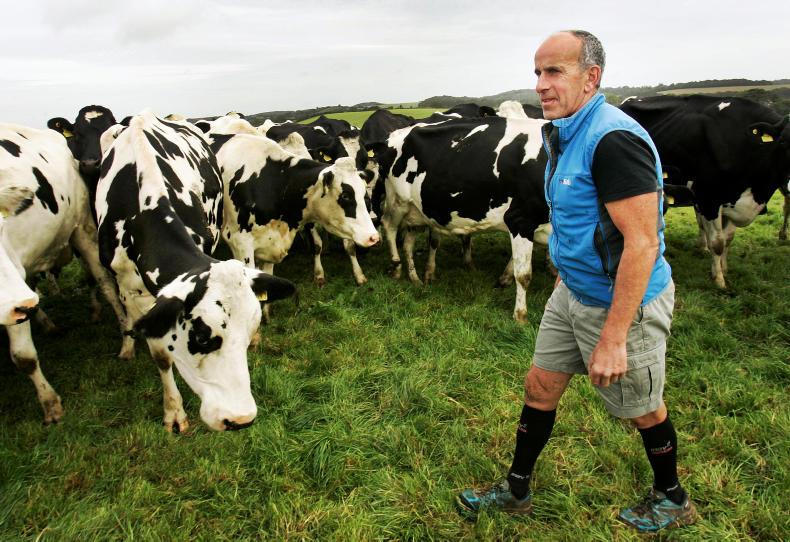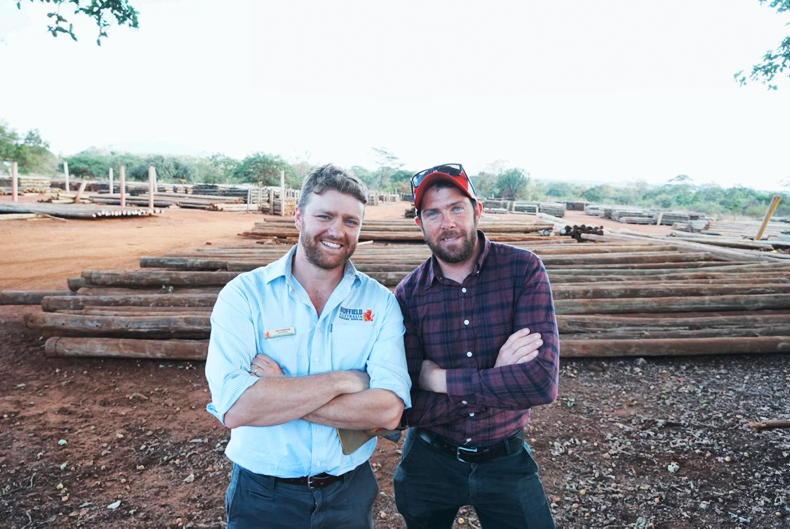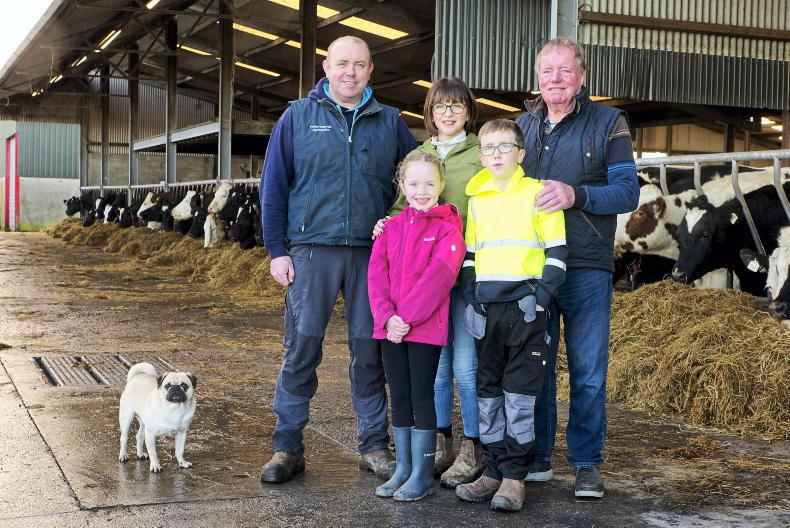Delayed turn-out of the whole milking herd made grass management slightly more difficult this year on the farm of Dairylink Ireland participant Stephen Wallace near Seaforde, Co Down.
While 30 cows got out to grass in February, breeding was in full swing and average milk yields were increasing, which influenced Stephen’s decision to hold these cows inside on a total mixed ration.
However, during March, any cow delivering less than 35 litres/day went to grass.
Average cover is 782kg DM/ha (utilisable) on the milking platform this week.
Two paddocks were taken out for silage last week and three silage paddocks joined the grazing block. Both skipped paddocks had average covers over 1,950kg DM/ha.
Stephen is trying to manage grass this year, with the key rule of not allowing cows into pre-grazing covers above 1,800kg DM/ha.
So far, it has been working well, but weekly measurement is critical.
Average growth on the farm last week was 78kg DM/ha/day and the recent rain is expected to push growth on this week.
Grass wedge
The grazing block is currently 40ha in size and stocking rate is 4.3LU/ha.
Cover per cow is at 180kg and the wedge is well established, with pre-grazing covers around 1,700kg DM/ha.
Currently, the cows are averaging 29 litres/cow/day at 3.87% fat and 3.15% protein
A recent grass walk showed poor grass clean-out in some paddocks.
The herd on the Wallace farm is fed to yield in the milking parlour, so high-yielding cows that are producing over 30 litres/day will still be receiving over 6kg/day of concentrates.
Stephen is planning to move the parlour setting to maintenance plus 20 litres, which means cows yielding more than 20 litres/day will receive concentrates at 0.45kg/litre above this.
Currently, the cows are averaging 29 litres/cow/day at 3.87% fat and 3.15% protein.
In the paddocks with the high post-grazing covers, Stephen will top these this week and plans to skip another paddock or two if growth continues to increase.
Both steps will improve grass quality for subsequent grazing rounds.
Soil fertility
Soil analysis last winter highlighted shortfalls in soil fertility on the Wallace farm, with the main problem area being soil pH.
A total area of 34ha has been targeted to receive 2t of lime per acre. This work is currently ongoing, with lime applied immediately after grazing.
Two paddocks will be reseeded this month as both had been used to out-winter drystock on forage rape.
Urea was used for the first round of grazing at 30 units per acre and one bag of CAN was used for the last round
Seed varieties are yet to be selected, but will likely be late-heading high-energy varieties.
Urea was used for the first round of grazing at 30 units per acre and one bag of CAN was used for the last round.
Only three paddocks in the grazing block received slurry this year.
Stephen has a compound 20:10:10 in the shed, which will be targeted at paddocks with low phosphorus (P) and potassium (K) indices.
These paddocks will receive two applications of one and half bags per acre of 20:10:10 this year.
This will be in the third round and the fifth round, with the first compound application expected in late June.
Hitting targets with young stock
The young group of 54 heifers that are due for breeding in December 2019 are on an outlying farm.
The land block consists of four paddocks and the stock graze it in a rotation.
Target weight for these heifers at breeding is 360kg, which is 60% of the target mature weight of 600kg.
Average weights for this group of heifers at the last weight check at the end of April was 210kg.
This meant heifers needed to gain 150kg over seven months, equating to a daily liveweight gain of 0.72kg/day.
Heifers
While heifers are still on 2kg/head/day of concentrates, Stephen is considering removing this, as the required liveweight gain should be achievable from good-quality grass.
He will do another weight check later this month to monitor progress.
There are also 62 heifers that are scanned in-calf and are due to calve down from mid-August to mid-November.
This is a uniform bunch and it includes 15 purchased heifers. All heifers are due within a three-month period and they are all in-calf to sexed semen.

Heifer calves should be able to achieve a daily liveweight gain of 0.72kg/day from good-quality grass.
Breeding of these heifers was contracted out this year for the first time. The new arrangement has been successful, as it freed up Stephen’s time during the winter and compacted the replacement stock coming into herd.
Between calves from these heifers and the main milking herd, Stephen aims to have all replacement stock that will be due for breeding in late 2021 born within a 12-week window this autumn.
Busy at silage on Dairylink Ireland farms
Dairylink Ireland programme farmers have been busy at silage over the past seven to 10 days.
For example, James Martin in Dromintee got first-cut into his newly constructed silage pit last week.
In Omagh, Richard Marshall is also finished and has slurry and nitrogen planned for most of the silage area.
In general, most silage ground on the Marshall farm is receiving two and half bags of CAN and 3,000 gallons of slurry per acre after harvesting.
John Oliver in Limavady plans to get first-cut in this week. The silage ground was grazed earlier in the year, so it should still be good quality ahead of cutting.
Tracking heifer weights and keeping up with weekly grass measurements on the milking platform is on the to-do list for Dairylink farmers after silage and slurry.
Read more
Watch: Dairylink – early first-cut silage made in Tyrone
Watch: Dairylink Ireland farmers getting to grips with grass growth
Delayed turn-out of the whole milking herd made grass management slightly more difficult this year on the farm of Dairylink Ireland participant Stephen Wallace near Seaforde, Co Down.
While 30 cows got out to grass in February, breeding was in full swing and average milk yields were increasing, which influenced Stephen’s decision to hold these cows inside on a total mixed ration.
However, during March, any cow delivering less than 35 litres/day went to grass.
Average cover is 782kg DM/ha (utilisable) on the milking platform this week.
Two paddocks were taken out for silage last week and three silage paddocks joined the grazing block. Both skipped paddocks had average covers over 1,950kg DM/ha.
Stephen is trying to manage grass this year, with the key rule of not allowing cows into pre-grazing covers above 1,800kg DM/ha.
So far, it has been working well, but weekly measurement is critical.
Average growth on the farm last week was 78kg DM/ha/day and the recent rain is expected to push growth on this week.
Grass wedge
The grazing block is currently 40ha in size and stocking rate is 4.3LU/ha.
Cover per cow is at 180kg and the wedge is well established, with pre-grazing covers around 1,700kg DM/ha.
Currently, the cows are averaging 29 litres/cow/day at 3.87% fat and 3.15% protein
A recent grass walk showed poor grass clean-out in some paddocks.
The herd on the Wallace farm is fed to yield in the milking parlour, so high-yielding cows that are producing over 30 litres/day will still be receiving over 6kg/day of concentrates.
Stephen is planning to move the parlour setting to maintenance plus 20 litres, which means cows yielding more than 20 litres/day will receive concentrates at 0.45kg/litre above this.
Currently, the cows are averaging 29 litres/cow/day at 3.87% fat and 3.15% protein.
In the paddocks with the high post-grazing covers, Stephen will top these this week and plans to skip another paddock or two if growth continues to increase.
Both steps will improve grass quality for subsequent grazing rounds.
Soil fertility
Soil analysis last winter highlighted shortfalls in soil fertility on the Wallace farm, with the main problem area being soil pH.
A total area of 34ha has been targeted to receive 2t of lime per acre. This work is currently ongoing, with lime applied immediately after grazing.
Two paddocks will be reseeded this month as both had been used to out-winter drystock on forage rape.
Urea was used for the first round of grazing at 30 units per acre and one bag of CAN was used for the last round
Seed varieties are yet to be selected, but will likely be late-heading high-energy varieties.
Urea was used for the first round of grazing at 30 units per acre and one bag of CAN was used for the last round.
Only three paddocks in the grazing block received slurry this year.
Stephen has a compound 20:10:10 in the shed, which will be targeted at paddocks with low phosphorus (P) and potassium (K) indices.
These paddocks will receive two applications of one and half bags per acre of 20:10:10 this year.
This will be in the third round and the fifth round, with the first compound application expected in late June.
Hitting targets with young stock
The young group of 54 heifers that are due for breeding in December 2019 are on an outlying farm.
The land block consists of four paddocks and the stock graze it in a rotation.
Target weight for these heifers at breeding is 360kg, which is 60% of the target mature weight of 600kg.
Average weights for this group of heifers at the last weight check at the end of April was 210kg.
This meant heifers needed to gain 150kg over seven months, equating to a daily liveweight gain of 0.72kg/day.
Heifers
While heifers are still on 2kg/head/day of concentrates, Stephen is considering removing this, as the required liveweight gain should be achievable from good-quality grass.
He will do another weight check later this month to monitor progress.
There are also 62 heifers that are scanned in-calf and are due to calve down from mid-August to mid-November.
This is a uniform bunch and it includes 15 purchased heifers. All heifers are due within a three-month period and they are all in-calf to sexed semen.

Heifer calves should be able to achieve a daily liveweight gain of 0.72kg/day from good-quality grass.
Breeding of these heifers was contracted out this year for the first time. The new arrangement has been successful, as it freed up Stephen’s time during the winter and compacted the replacement stock coming into herd.
Between calves from these heifers and the main milking herd, Stephen aims to have all replacement stock that will be due for breeding in late 2021 born within a 12-week window this autumn.
Busy at silage on Dairylink Ireland farms
Dairylink Ireland programme farmers have been busy at silage over the past seven to 10 days.
For example, James Martin in Dromintee got first-cut into his newly constructed silage pit last week.
In Omagh, Richard Marshall is also finished and has slurry and nitrogen planned for most of the silage area.
In general, most silage ground on the Marshall farm is receiving two and half bags of CAN and 3,000 gallons of slurry per acre after harvesting.
John Oliver in Limavady plans to get first-cut in this week. The silage ground was grazed earlier in the year, so it should still be good quality ahead of cutting.
Tracking heifer weights and keeping up with weekly grass measurements on the milking platform is on the to-do list for Dairylink farmers after silage and slurry.
Read more
Watch: Dairylink – early first-cut silage made in Tyrone
Watch: Dairylink Ireland farmers getting to grips with grass growth











SHARING OPTIONS